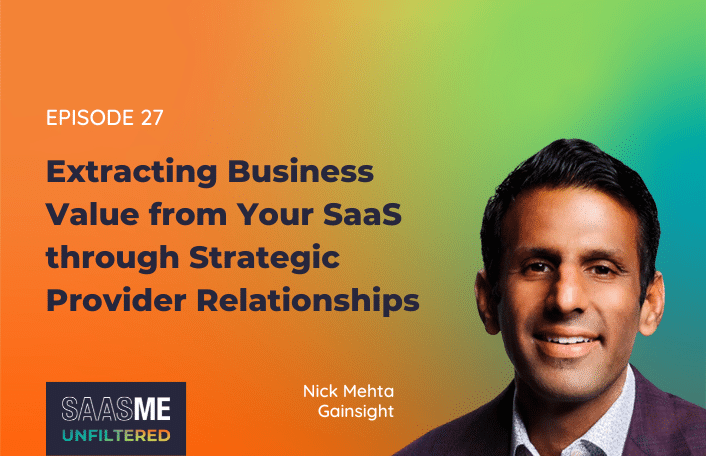07/06/2023
Table of Contents
What value are you truly getting out of your SaaS applications? Nick Mehta, CEO at Gainsight, knows all too well how important it is to drive business value from your software. In fact, he and his team have developed a customer success approach that’s taken over the global SaaS business model. In this episode, Nick shares how to create more strategic relationships with your SaaS providers and realize significant value for your organization.
Episode Summary
Often, the first thing that comes to mind when you hear ‘ROI’ is financial value. However, it’s more than that when it comes to your SaaS investments.
“I think that one of the things that’s interesting,” said Nick Mehta, “is there’s a lot of other types of value between a vendor and a buyer.
It comes down to the relationship you have with your SaaS providers. They should serve as a partner or advisor, guiding your organization to value.
The truth is, according to Mehta, “The best vendors right now are able to have good deployment, great engagement, adoption, ROI, but also are in a fundamentally sticky position in the stack right now.”
Not to mention, they’re strategic, prescriptive, and showing you the best way to get the value.
Guest Spotlight
Name: Nick Mehta
What he does: CEO at Gainsight
Connect with Nick online: LinkedIn
Episode Highlights
Value Is about More Than Just ROI
“There’s a financial value. I think that one of the things that’s interesting is there’s a lot of other types of value between a vendor and a buyer. There’s alignment to my strategic priorities. Lots of times software isn’t on its own driving financial value. It’s a tool that’s part of a strategy that the buyer has to basically drive some change in their business. For example, the buyer might be launching a new business and the new business, let’s say it’s a cloud business, and they need a set of technologies to help enable that. Those technologies on their own aren’t driving value, but they’re kind of a lever to the strategy. The strategy is what’s going to drive value. I think there’s financial value, there’s strategic value. Another value that we don’t talk enough about is the professional value. We’re selling to companies. We’re also selling to human beings. For those human beings, the software helps them get recognition and promotion and maybe even the next job in some cases. That’s obviously not necessarily what the company cares about, but the human beings care about that too.”
Buyers and SaaS Providers Must Align on Value
“I think that part of the vendor, the provider’s job is to help the buyer understand the value of what they could be doing. The analogy I like to use is you think about trying to work out and get in shape and you work with a personal trainer, and if you’re a super hardcore athlete and you work with a personal trainer, you might go to that personal trainer and be like, ” Look, I want to do plyometrics on this day and I want to do heavy lifting on this day and I want to do whatever.” Or you might be like most people and go to the personal trainer and be like, “What are your goals?” You’re like, “I don’t know, I just want to get in better shape.” Then they’re like, “Well, specifically here’s a pattern of five different types of things we’ve seen. Some people want to get bigger, some people want to get more lean. Some people think about long-term health.” Then the personal trainer kind of guides you through defining the value you’re going to get from the personal training and then from those value, then if it’s like, I’m going to get leaner, then they might say, “Well, to get lean, we’re going to do a combination of HIIT exercises and Pilates or whatever.” They’re guiding you to that. They’re not just asking you an open-ended question and expecting you to be the expert. I think the same thing is true with vendors.”
Value Realization, Powered by Data
“When people buy our software, one of the things they often want to do is literally just make their team more scalable and make their team be able to manage more customers, get more efficient, et cetera, et cetera. We have a very rigorous process where we look at, okay, how many customers are being managed by person and how many hours are they spending per week on different activities pre- sale. Right? That’s our level set. Then after the sale, after the deployment, we go back and we actually measure how things have gotten better. We actually have this stat now that the average customer of ours saves per person seven hours per week. At a 40 hour week approximately seven hours a week, you’re getting back and then you can deploy that to take you on more accounts or doing a better job. I think then it’s more believable because you’ve actually measured it on real world evidence versus I just took a spreadsheet and I put in a number and multiply times a million, and that’s your output. That’s not very believable. People call this value realization. It’s not just about the value definition, it’s about what value have I actually realized.”
The Best Vendors Lead with Value
“The best vendors right now are able to have good deployment, great engagement, adoption, ROI, but also are in a fundamentally sticky position in the stack right now. From a buyer perspective, you don’t necessarily want to be too sticky to a vendor, so you probably want to maintain some optionality, but at the same time you’re not trying to deal with too many vendors. For mission critical things, you’d love to have somebody who can really just take care of it and do it well. I think what I love about this podcast is there’s a lot of benefit in the long term of transparency between the vendor view of the world, which is kind of my world and the buyer view of the world, which is your world. Then how do we bring those together so we just agree this is how we’re looking at value, this is what we’re trying to achieve, let’s share the data, let’s help you make a good decision, love what you guys are doing because of that.”
Vendors Should Be Prescriptive on the Path to Value
“We as vendors need to be brave and be prescriptive. We need to show the client the best way to get to this value. Again, using the personal trainer analogy, the personal trainer is telling you all kinds of things you’re doing wrong. I had my session yesterday and she’s like, ” Yeah, your back’s too arched. Your core’s not tight enough and you need to keep your arms in your body.” I’m paying her to do that. I’m happy she does that. We need vendors and CSMs and salespeople to step up and show the client the best way to get the value and not be afraid of it because the client’s hiring you for that. Right? They’re hiring you to get the best way to get to this path to value. That may mean the best way to deploy the product or to use it or to roll it out and to be prescriptive about that versus waiting for the client to say, ‘Oh, how should I do this?’ It’s the most annoying thing in the world when the client’s like, ” Hey, what do you recommend?” The vendor’s like, ‘I don’t know. What do you want to do?’”
Top Quotes
5:57 – “Lots of times software isn’t on its own driving financial value. It’s a tool that’s part of a strategy.”
9:00 – “The provider’s job is to help the buyer understand the value of what they could be doing.”
28:33 – “The best vendors right now are able to have good deployment, great engagement, adoption, ROI, but also are in a fundamentally sticky position in the stack right now.”
35:09 – “Show the client the best way to get the value.”
Recommended Resources
Check out other episodes here, Apple Podcasts, Spotify, or wherever you listen to podcasts.
ABOUT THE AUTHOR

Cory Wheeler
As Zylo’s Chief Customer Officer, Cory is responsible for helping our customers drive ROI and SaaS Management success with Zylo. He helps companies of all sizes effectively discover, optimize, and govern their SaaS through Zylo’s platform and services. Prior to founding Zylo, Cory spent 15 years in finance and procurement, managing categories and sourcing teams at Arthur Andersen, BearingPoint, and both Takeda and Astellas Pharmaceuticals. He built the procurement organization at ExactTarget, and managed the integration with the Salesforce Marketing Cloud procurement organization in 2015. He and his family reside in Indianapolis, IN, where they can be found cheering for the Purdue Boilermakers and Chicago Cubs.

